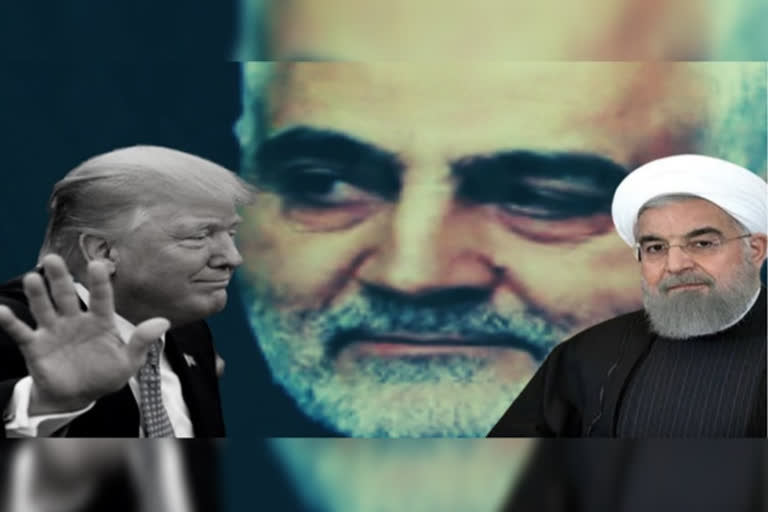New Delhi: Joint Comprehensive Plan of Action (JCPOA) was flagged as a major achievement to contain Iran’s nuclear ambitions by the previous US administration under President Obama. But the next President Donald Trump had vowed to junk it. This was the beginning of an end.
Ever since Trump withdrew from the nuclear deal and applied maximum pressure tactics and imposed wide-ranging sanctions on Iran to tame it.
It also used the already deepened Shia –Sunni divide and the new fault lines and cast the lot with the Saudis and indirectly with Israel due to their existential animosity to one another. Under Jared Kushner, a welcome change had begun with Israel reaching it to its gulf neighbours but the Iranian challenge was accentuated further leading to greater volatility in the region which is already marred by several conflicts where Iranian hand and influence were quite visible.
Libya, Yemen, Iraq, Gaza, Syria and Lebanon became the counterpoise to US interests. Iran indeed has close relations with several non-state actors like Hezbollah, Hamas, Houthis and Shia militia groups in Iraq among many others which provide it with the tools of expanding influence.
US withdrawal from JCPOA led to more negative developments that verged on more sabre-rattling in the Persian gulf leading several incidents in the Strait of Hormuz so crucial for trade and energy transit.
Fortunately, the shooting down of US military drone and several ships in the gulf as well as drone strikes on the Saudi oil facilities remained contained since no direct response was made. But then President Trump decided to order the assassination of Major General Qassem Soleimani, head of the Iranian Al Quds forces near Baghdad airport in response to an American contractor killed on December 27 in a militia attack.
Another high profile pro-Iranian militia leader Al Muhanadi was also killed in the drone strike. A redline was breached as the killing of serving Generals by foreign governments so blatantly has not been the norm of engagement. Moreover, this happened rather suddenly as both sides have been deflecting war and were working for some kind of understanding and dialogue through several intermediaries.
The shock and grief in Iran were natural and evident in the kind of huge crowds that were drawn to Solemani’s funeral chanting revenge and death to America. The Twitter war was on and real escalation seems to be on the horizon with attendant disastrous consequences.
No wonder the Supreme leader Ayatollah Khameini and other leaders vowed for retaliation and revenge. Americans were forced to evacuate their embassy personnel and other US citizens as Iraq, hitherto under their control, was peeved as its sovereignty was violated by the arbitrary and reckless US action. The Iraqi Parliament decided to ask Americans to leave the country probably is the worst geo-strategic loss.
Hitherto US was ambivalent about its continued military presence in the region and was seen to be in withdrawal mode from Afghanistan to Syria but this and some other past incidents and accidents have forced it to beef up its military presence and consequently enhanced the danger to American interests and assets rather than reducing it.
On their part, Secretary Pompeo justified the killing of Soleimani reiterating rather inanely “ It’s very clear the world is a safer place.
Qassem Soleimani no longer walks the planet. President Trump made the right decision to stop Soleimani from the terror campaign that he had been engaged against America and prevent the future plans “ In response to the Iranian pledge of revenge. Trump came out with a list of 52 cultural targets to decimate Iran should it indulge in bravado.
Every action has a reaction but in this case, it may not be an equal and exactly opposite reaction. However, the pro-Iranian militias, termed as proxies by the US and its allies, may have their own vengeance plans.
All the US allies have called for restraint and de-escalation although miffed by unilateral actions of this sort which in a chain reaction has the seeds to blows up the region which no one can afford.
Read also: Weeping, Iranian supreme leader prays over general slain by US
For the time being the war of words is in the fray on all sides. But the damage has been done. Iran has further appropriated the right to use more centrifuges for enrichment purposes and the divorce between the US and Iran is almost complete which will have its own long term repercussions given the fact that new power equations and prevailing hotspots in the region have enough charge to destabilise the global supply chains which will be disastrous for the global peace, economy and stability.
The increase in oil prices may help the coffers of some including the US but will have more negative impact on the friendly economies. Hopefully, peace will have some chance and the realpolitik will help the leaderships of the contending parties not to escalate the conflict further.
India, with its huge diaspora and dependence on energy supplies and remittances, has much to be worried about. Hence the Indian Foreign Minister spoke to his US, Iranian and Omani counterparts whom he had recently met. Iranian FM Javad Zarif was expected to speak at the Raisina dialogue next week but he might even make a stop in New Delhi even before that to consult as the diplomacy will have to regain the advantage. For the time being all efforts are being made by all stakeholders to avoid crossing the threshold but sometimes the non-state actors can trigger the charge.
Read also: Thousands turn out for Soleimani's funeral in Iran



